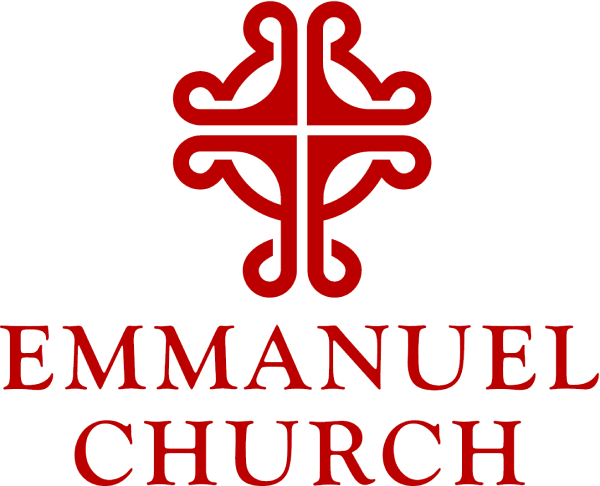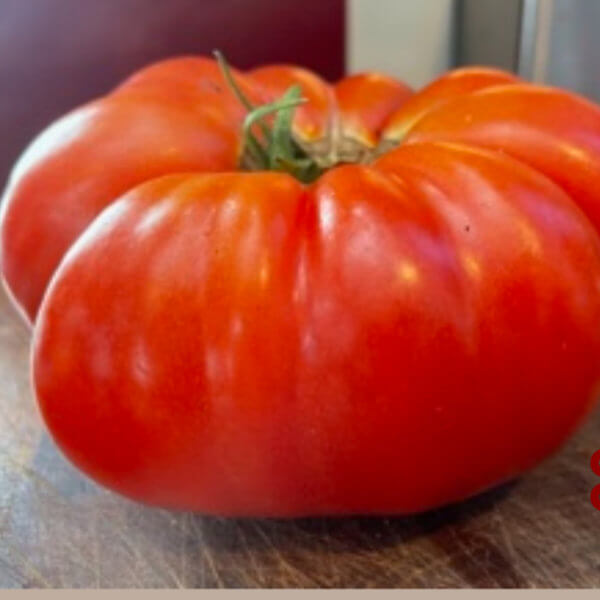
Home Grown Tomatoes
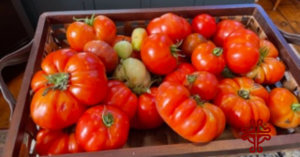 It’s tomato season in New England — or at least it is around Newport. Just have a look at the farm stands. There are beautiful, ripe tomatoes everywhere — beefsteak, Better Boy, Early Girl — and the gorgeous, multi-lobed heirloom kind — Black Krim, Cherokee Purple, and Mr. Stripey. People are posting closeups on Facebook with the pride and amazement of new grandparents posting endless baby pictures. Well, to be absolutely candid, a lot of those photos are mine, it’s true. But I have seen others!
It’s tomato season in New England — or at least it is around Newport. Just have a look at the farm stands. There are beautiful, ripe tomatoes everywhere — beefsteak, Better Boy, Early Girl — and the gorgeous, multi-lobed heirloom kind — Black Krim, Cherokee Purple, and Mr. Stripey. People are posting closeups on Facebook with the pride and amazement of new grandparents posting endless baby pictures. Well, to be absolutely candid, a lot of those photos are mine, it’s true. But I have seen others!
There is something no less than miraculous in the beauty of food growing out of the ground — the extravagant health of the vines, the brilliant little yellow flowers, striving to show their eager little faces to the sun. My friend Joan and I grew tomatoes together for 20 years in Atlanta. Guy Clark’s song Home Grown Tomatoes was our urban farm harvest song — Ain’t nothin’ in the world that money can’t buy, except true love and home grown tomatoes!
Tomato Sandwich
So what do we do with this lavish bounty? Well, there’s tabbouleh, ratatouille, and tomato sauce. But in my personal view, there’s no better use than the tomato sandwich. For bread, I use the old Jim Lahey New York Times recipe — very little yeast in a really wet dough, baked in a super hot oven. Talking mayonnaise is as rife with potential conflict as politics in an election year, so just imagine your favorite one — Duke’s, Hellman’s, Miracle Whip — or even an artisanal aioli made from cage-free eggs and hand-picked herbs. It’s up to you.
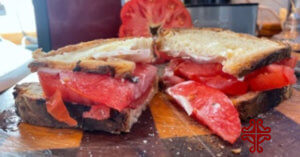 A good tomato sandwich also needs a super thin slice of sweet onion — like Vidalias, from Georgia, although the Egyptian walking onions in my garden can work, and a small pinch of coarse salt. This incredible once-a-year treat food, God’s gift of sun, earth, sky, and water, must be eaten over the sink, because it’s deliciously messy.
A good tomato sandwich also needs a super thin slice of sweet onion — like Vidalias, from Georgia, although the Egyptian walking onions in my garden can work, and a small pinch of coarse salt. This incredible once-a-year treat food, God’s gift of sun, earth, sky, and water, must be eaten over the sink, because it’s deliciously messy.
So now you know what I’ve been doing for lunch this past week.
Sweet drips of juicy, warm tomato, mixed with the milky white of my secret favorite mayonnaise, saturate the perfect crumb of the fresh bread and fall into the kitchen sink as I worshipfully enjoy my tomato sandwich.
Eat My Flesh
The image of the messy goodness of my tomato sandwich stayed in my head at my desk this week as I reflected on John’s gospel, which is one of the most troubling and difficult passages in scripture for me.
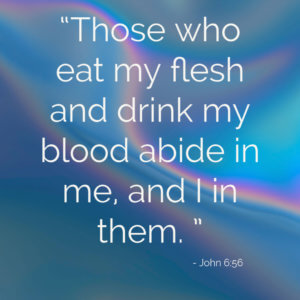 Very truly, I tell you, unless you eat the flesh of the Son of Man and drink his blood, you have no life in you. …My flesh is true food and my blood is true drink. Those who eat my flesh and drink my blood abide in me, and I in them.
Very truly, I tell you, unless you eat the flesh of the Son of Man and drink his blood, you have no life in you. …My flesh is true food and my blood is true drink. Those who eat my flesh and drink my blood abide in me, and I in them.
Any of you who grew up on the 1928 Book of Common Prayer, as I did, may remember the words of the Prayer of Humble Access, which is still present in Rite I Holy Eucharist:
We do not presume to come to this thy Table, O merciful Lord, trusting in our own righteousness, but in thy manifold and great mercies. We are not worthy so much as to gather up the crumbs under thy Table. But thou art the same Lord whose property is always to have mercy.
From childhood, I loved this prayer, with its beautiful poetry, and the expansive description of God’s manifold and great mercies. But when I reached my teen years and into college, I began to focus on the other language — the language from today’s gospel:
Grant us therefore, gracious Lord, so to eat the flesh of thy dear Son Jesus Christ, and to drink his blood, that we may evermore dwell in him, and he in us. Amen.
Eat Jesus’ flesh, and drink his blood? These words felt disturbing and scary. I would ponder the language as I prayed the Prayer of Humble Access aloud on Sundays, lips pressed together in troubled silence when we got to the flesh and blood part. Maybe God will give me a pass on my youthful reticence over this language. Because the crowd listening to Jesus in today’s gospel has exactly the same reaction: How can this man give us his flesh to eat? they ask.
So Jesus tells them again, Very truly — Biblical Greek for “LISTEN UP, GUYS!” — Very truly I tell you, unless you eat the flesh of the Son of Man and drink his blood, you have no life in you. As New Testament professor Audrey West observes, Two thousand years of theology and interpretation have buffered us from the horror of this image. Why would Jesus teach with such a shocking metaphor — used seven whole times in as many verses? In this very same passage, Jesus says, I am the living bread that came down from heaven. Whoever eats of this bread will live forever; and the bread that I will give for the life of the world is my flesh. Those who eat my flesh and drink my blood have eternal life, and I will raise them up on the last day; for my flesh is true food and my blood is true drink.
A Disturbing Metaphor
There is no history of cannibalism in the Ancient Near East. And we know from John’s gospel that the Judeans listening to Jesus were as shocked and confused by this disturbing metaphor as we are today when we pause to think about it.
As preacher Matt Fitzgerald writes, Maybe it makes us feel too close to God — to God’s fleshy, incarnate reality. Wouldn’t we rather just contemplate belief than consume the flesh and blood of Jesus? If I’m being candid, I have to really wonder. This language feels unsettling, and Jesus means it that way. There is no other reason to repeat this image seven times in as many verses, while also reflecting the crowd’s incredulous response to these disturbing words. Yikes — Let’s just sit in the pew and think instead. That feels so much less scary, committed, and messy.
Jesus catches us at that very predictable response. Jesus is pointing right at our temptation to tidy faith — easy religion — here. The eternal life Jesus is describing is an engaged, all-in, courageous faith. Jesus is describing the internalization — eating right up all that Jesus teaches and means about the real, human, incarnate nature of our God, and making it part of our very lives and bodies in a real way.
 Jesus’ extravagant, repeated invitation to eat his body and drink his blood is not a tidy, elegant social invitation to come dressed up once a week on Sundays to a carefully maintained, controlled environment to pray for an hour. This is an abundant, repeated, endless invitation to eternal life. What are we hungry for, after we’ve eaten our fill of empty calories — fried chicken and doughnuts — what do we still need? We are nourished with the body and blood of Jesus — being and becoming what we pray and practice, not just on Sundays but all of the time, and in all that we do.
Jesus’ extravagant, repeated invitation to eat his body and drink his blood is not a tidy, elegant social invitation to come dressed up once a week on Sundays to a carefully maintained, controlled environment to pray for an hour. This is an abundant, repeated, endless invitation to eternal life. What are we hungry for, after we’ve eaten our fill of empty calories — fried chicken and doughnuts — what do we still need? We are nourished with the body and blood of Jesus — being and becoming what we pray and practice, not just on Sundays but all of the time, and in all that we do.
It’s scary — totally out of our control. It’s extravagant, lavish, exciting, delicious, heartbreaking, life-giving, and messy. The eternal life Jesus describes is just dripping with sunny goodness like a perfect tomato sandwich in August, with juices that run down your chin and land on the front of your shirt. And that’s ok. In the words of prominent 20th century theologian Tom Robbins in Even Cowgirls Get the Blues, “If life gets messy, eat it over the sink.” Amen
